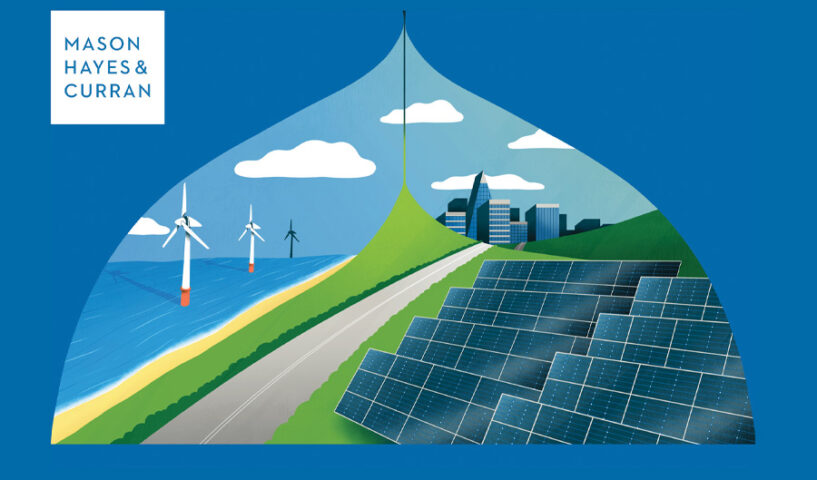
Huawei Ireland FusionSolar: Elevating solar energy solutions
29th May 2024
The energy transition and solar power: A critical inflection point
29th May 2024Powering Prosperity: Ireland’s Offshore Wind Industrial Strategy

Powering Prosperity: Ireland’s Offshore Wind Industrial Strategy was launched in March 2024. A first-of-its-kind for Ireland, the Strategy has an overarching objective to maximise the economic benefit of reaching both Ireland and Europe’s offshore renewable energy targets.
It maps out a pathway to 2030 for Ireland’s domestic capability to contribute towards the offshore wind sector both here and abroad. It also aims to attract foreign direct investment (FDI) to Ireland. The Strategy’s two key areas are (i) the development of a thriving offshore wind supply chain, and (ii) the establishment of a productive Research, Development and Innovation environment.
The Strategy sets out how Ireland can maximise the economic impact of future renewable energy use, increase Ireland’s global competitiveness in security of supply and price, and achieve stable regional economic development in Ireland.
The Strategy is based on four core pillars, with the first version of the Strategy covering 2024 and 2025:
- offshore wind supply chains;
- research, development and innovation;
- future demand and end-uses for renewable energy; and
- balanced regional economic development opportunities.
Ireland’s 2030 ambitions and targets
Ambitions
- develop an innovative enterprise ecosystem, with indigenous and multinational companies, which will provide world-leading service to the offshore wind sector;
- significantly scale up the enterprise base to service the offshore wind sectors in Ireland and globally;
- deliver 5,000 jobs in the offshore wind sector and associated sectors;
- increase opportunities for companies and investors to develop a successful supply chain;
- assist enterprise, workers, and the Research, Development and Innovation (RD&I) environment in availing of these opportunities through funding and supports;
- establish a National Offshore Wind Centre of Excellence and a new Floating Offshore Wind Demonstrator;
- create strategic partnerships with like-minded countries;
- collaborate with stakeholders to develop world-class property solutions powered by renewable energy;
- develop major industrial hubs around key deployment and Operations and Maintenance ports; and
- transform Ireland’s regional capability and deliver employment opportunities throughout the island.
Vision
The Strategy details the vision for Ireland’s energy landscape, including future energy demand projections. It sets out a path to a new model for Ireland’s economy and society, and aligns the Strategy with national and EU policy on sectoral emissions targets as well as offshore wind ambitions in Ireland and across the EU.
The criticality of a sound investment case for offshore wind at such scale is acknowledged in the Strategy. It references the development of new industrial strategies and property solutions that will be required to drive the demand for the expected excess renewable energy.
Actions and targets
The key actions, the deadlines set for their achievement and the entities considered to be their “owners” are set out in Appendix A.
Actions include:
- scale Ireland’s offshore wind capability through the delivery of long-term strategic funding options to support scaling Irish offshore wind energy supply chain companies;
- drive increased start-up and high potential start-up generation in offshore wind, with enhanced entrepreneur development programmes and targeted funding supports;
- compete internationally to win large investments of scale;
- promote Ireland as a high-potential offshore wind energy market;
- engage with Northern Ireland’s Department for the Economy and ITI on potential all-island supply chain opportunities;
- engage with existing structures, identify RD&I focus areas / major challenges facing industry regarding offshore wind energy;
- progress the development of a National Offshore Wind Centre of Excellence;
- investigate the feasibility of a floating offshore wind demonstrator site;
- examine the case for the development of a regulatory sandbox for offshore wind and related technologies;
- assess the potential for accelerating the development of a West Coast Designated Maritime Area Plan (DMAP) and examine the cost and viability of initiating floating offshore wind projects in this DMAP;
- undertake further work to assess the role that integrated energy parks could play in Ireland’s future energy system; and
- establish a pilot framework to enable aligned delivery of offshore generation, grid and routes to market.
Appendix B sets out that work will be undertaken in 2024 to obtain reference data and set projected targets for the following areas:
- spend on R&D in the supply chain;
- the number of jobs in the offshore wind supply chain;
- new start-ups in the offshore wind supply chain;
- exports of goods and services; and
- FDI potential.
The Strategy provides clear targets and ambitions for Ireland to grow in indigenous wind energy generation and to contribute internationally, while providing employment opportunities in a growing industry.
 For more information and expert advice on the impact of the Strategy’s ambitions on your organisation’s operations, contact Eoin Cassidy or another member of the market-leading Energy team at Mason Hayes & Curran.
For more information and expert advice on the impact of the Strategy’s ambitions on your organisation’s operations, contact Eoin Cassidy or another member of the market-leading Energy team at Mason Hayes & Curran.
